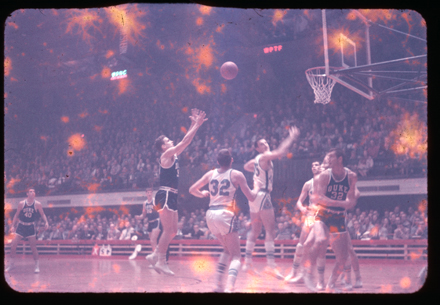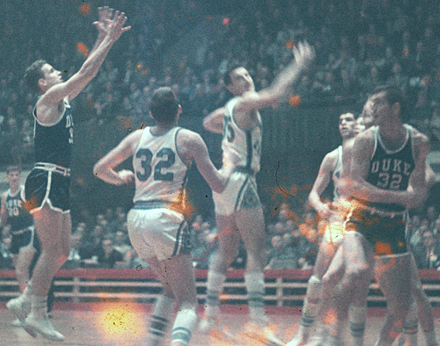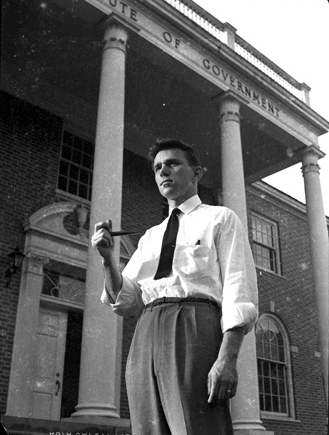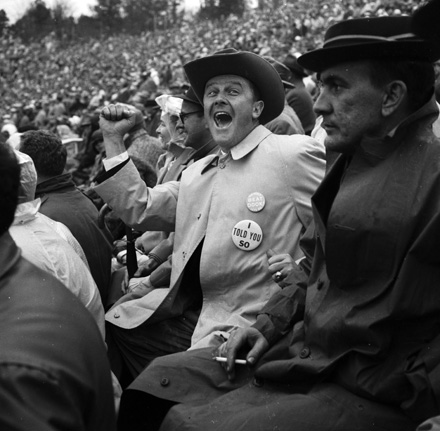I am fond of serendipity—rooted, perhaps, in the photographer part of me. Most of my personal photography comes from exploration, not from preconceptions. Serendipity is not, however, aimless wondering. You have to be “tuned in” to what may present itself.
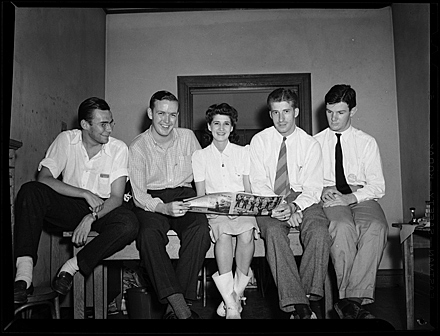
Last Friday was the first day we had students from the School of Information and Library Sciences (SILS) digital library class here to scan negatives. For the material to be scanned, Elizabeth and I selected in advance Hugh Morton’s negatives made during his years as a student at UNC. We thought as students themselves they’d have some connection to the images, and it would give us a glimpse into student life on campus in the pre- and early World War II era.
While setting up the workspace on Friday morning, I wanted to walk through the work flow in preparation for the students arrival. I picked out a negative—the image above—that looked too challenging for them to scan right off the bat because the faces and lighter clothing were overexposed. Scanning it gave me some fits, so I decided to try again later. I did, however, recognize on the cover of a Daily Tar Heel newspaper (held by a woman who may be Olive Consecu, secretarial staff member of the student publication The Carolina Magazine) a scene similar to a Hugh Morton negative that I had scanned months earlier while “rummaging” (see below).
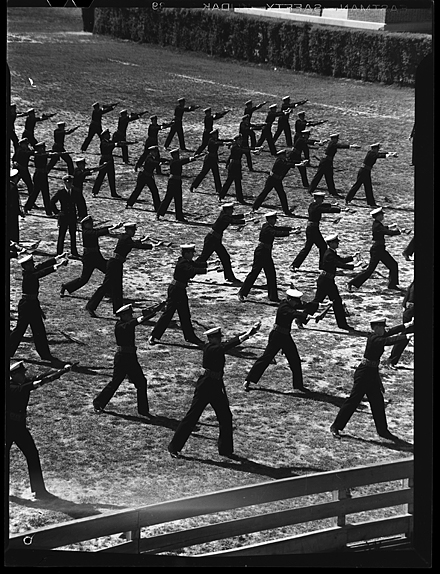
At the end of the day, I launched back into rescanning the negative. With a better scan in hand, I zoomed into the image to see if I could read the issue date, but all I could discern was that the month had a short name, presumably “May,” and that, with the exercising trainees in naval uniforms, it was likely after 7 December 1941. Then, without thought, I recognized that the picture to the left, on the back page, was another Morton negative that I had scanned during that same rummaging phase.
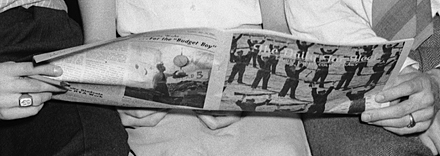
So off I went to the bound volumes of the DTH. At first I could not find the issue. The newsprint is very fragile, so I was carefully handling only the tops of the pages, looking for the full-bleed printed image. Every page was columnar. For each publication volume, however, there are three bound sets. One of the three bound sets was extremely fragile and detached from the spine . . . .
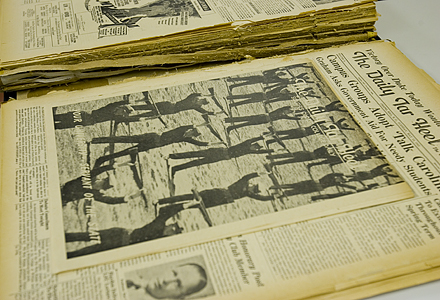
While gingerly turning pages . . . Voila! I uncovered a special edition smaller than the regular daily issues.

Entitled Your University—Servant of the State, the issue’s twenty pages feature UNC’s shifting roles within the war effort. As then DTH editor Orville Campbell stated, “This is your University. Those who run it for you know that you want them to do everything possible to prepare the youth of this state and nation for service. To that end they are working. We who are students feel that the story of how your University serves the state, the nation, and you needs to be told. To that end The Daily Tar Heel, the students’ newspaper, is publishing this special edition.”
The newspaper credits Hugh Morton, student photographer, for the cover photograph of “NROTC boys going though some physical arm conditioning exercises.” So while the negative above is not the same image as the photograph on the cover, both were very likely shot at the same scene.
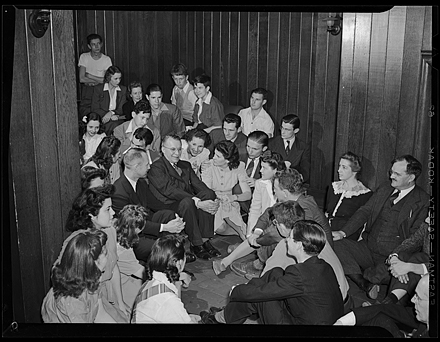
A quick examination of the negatives we set aside for the SILS project revealed more images similar to those that appeared in the DTH special edition. Yesterday’s group of students scanned a negative of Sir Gerald Campbell, then British Consul General to the United States, surrounded by eager students (see above). Again it is not the same image as the one published.
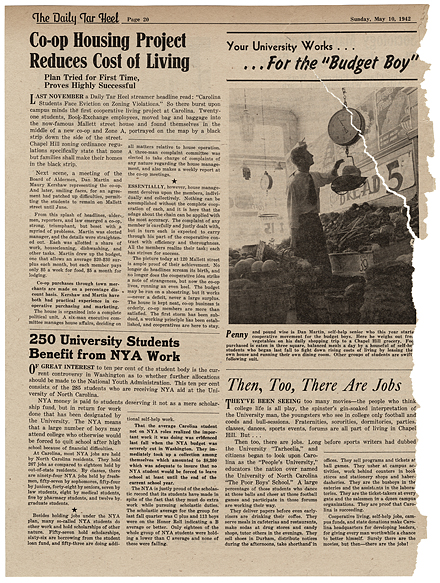
The caption for the photograph on the back page of the special edition (pictured above) begins, “Penny and pound wise is Dan Martin, self-help senior who this year started a cooperative movement for the budget boys. . . .” Martin was an instrumental player in the first cooperative living project at UNC. He was one of a group of students who moved into a house on Mallett Street in an effort to “fight down rising costs of living.” A scan from a negative with Martin in a very slightly different pose follows.
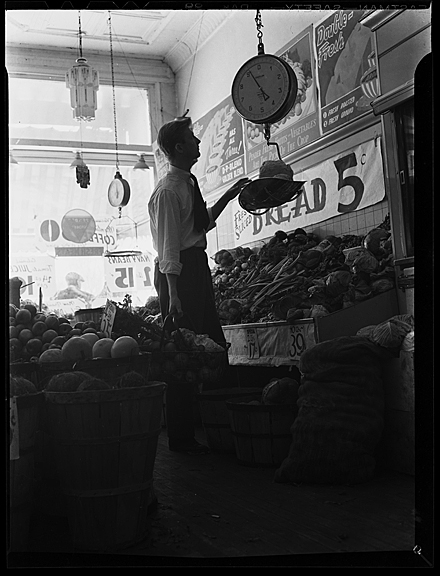
To wrap things up, let’s go back to the negative that started all this. Note the “LET’S TALK CAROLINA” button worn by the fellow on the far right (detail below).
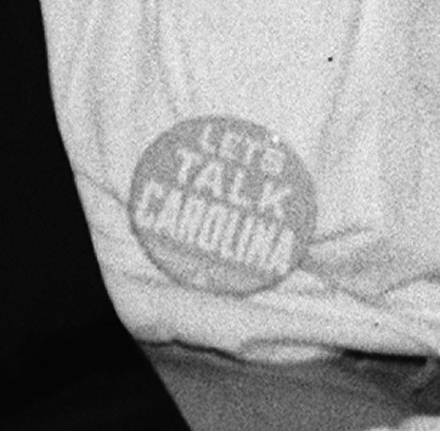
The front page of the regular May 10th edition of the DTH features an editorial, “Talk Carolina,” by Orville Campbell that described the university, confronting dropping enrollment for the fall in the face of war, as being “on the threshold of institutional pathopsychoneurosis.” He continued, “We are the doctors, the cure-all smart boys, if you will, that can change it to an electric magic portal.” Calling upon UNC’s 3,500 students to be salesmen for the university, he proclaimed “That war means clamps for Carolina if we don’t let our friends and their friends in on what we know about it.” The following day, the DTH reported that several campus organizations had rallied behind the idea and that buttons had been ordered for sale at cost. Roland B. Parker, Dean of Men, bought the first button on May 18th.
A trove of information serendipitously discovered . . . just because a negative looked to be a bit too challenging to scan!
Category: UNC
Duke versus UNC Basketball
Building the Morton digital library (with a little help)
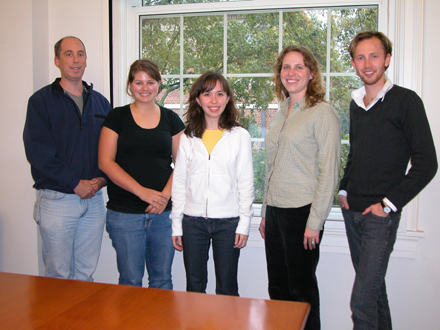
One of the best aspects of working in an academic library/archive is the proximity of and access to students. For one, you can hire them to help with some of the more tedious and repetitive aspects of archival processing! But more importantly, they get on-campus access to valuable hands-on learning opportunities—and you get the benefit of their technological skills and expertise, not to mention the energy and fresh perspective they bring to projects.
Luckily, UNC-Chapel Hill boasts one of the top graduate schools of Information and Library Science in the country (currently tied for #1 in the U.S. News and World Report!). This is especially good news for us at “A View to Hugh,” because we’ll be working this semester with UNC SILS professor Jeffrey Pomerantz and the members of his Digital Libraries class (a few of which are pictured above) to begin developing an online presence for the Hugh Morton collection. Our (overly ambitious?) goal is to have a prototype up and running by the end of the semester.
The class has met a few times and have already split themselves into nine intimidating-sounding working groups: Project Management, System Administration, Digitization, Standards, Metadata, Information Architecture, Services, Evaluation, and Preservation. We’re very excited about the project and will post regular updates about how it’s going. Perhaps we’ll even hear from some of the students themselves on this very blog (if they want a good grade, that is . . .).
How times have (and haven't) changed at UNC
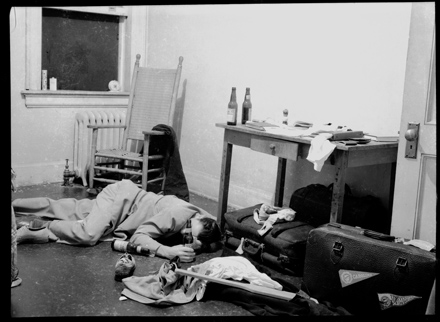
A recent news feature in the UNC-Chapel Hill student paper, the Daily Tar Heel, about alcohol use among students reminded me of these photos from Hugh Morton’s days on campus. It seems that college kids will be college kids, whether it’s the early 1940s or the 2000s. I have to say, though, that these first two images look somewhat staged to me. Morton worked as a photographer for the DTH, the Yackety Yack (yearbook), and other campus publications while he was a student—maybe he set these shots up to go with some piece of hard-hitting investigative journalism?
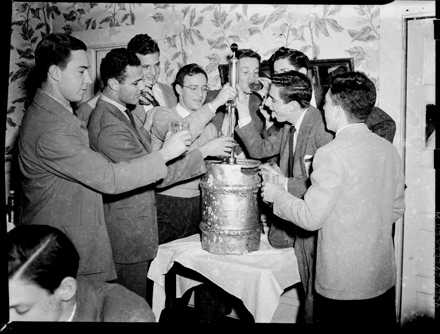
Or perhaps not so hard-hitting after all. Stephen and his freakish memory recognized the image below from the student publication Tar an’ Feathers, a cheeky, sometimes raunchy humor magazine put out from 1940-1942, for which Morton was photographer (and may have contributed other material). A cropped version of the image appears at the bottom of page 15 in the April 1942 issue, with a caption that reads:
“A shot by Hugh Morton showing what happens in the split second when a beer can is opened. Joe Miller stooges, while Elmo Hollingshead soberly contemplates.”
(The Tar an’ Feathers is so rich that I’ll have to save it for a later blog post; in the meantime, if you’re interested in UNC student publications you can check out the exhibit Tar Heel Ink, which the North Carolina Collection Gallery produced in 2005.)
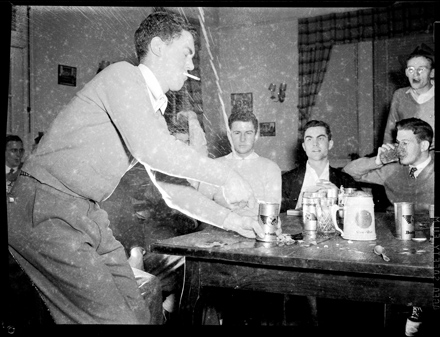
One thing has changed on campus very recently, and that’s the expansion of the No Smoking Policy which extends non-smoking areas to 100 feet from University facilities (forcing smokers to gather under the flagpole at the center of the quad). Gone are the days when students (or anyone, for that matter) can puff at will as the fellow pictured below was able to do when Morton snapped his photo.
Bear wrestling
In a new article about the Morton photographs from the Fall 2007 issue of UNC Friends of the Library’s Windows Magazine, entitled “Capturing Seven Decades of Life in North Carolina,” author Ginger Travis compares processing the Morton collection to “wrestling a bear.” I find this particularly funny because for the past few days I have been sorting through images of—you guessed it—BEARS!
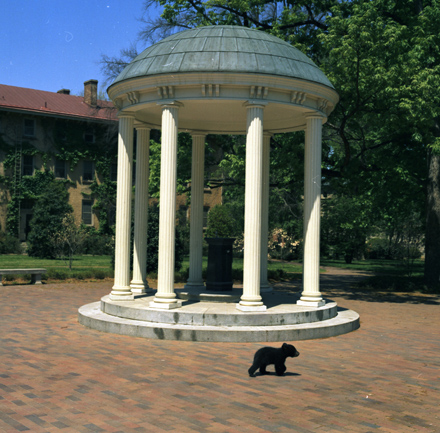 One set of negatives caught my attention early on—a series featuring an adorable black bear cub up to hijinks at various North Carolina landmarks (Biltmore, the State Capitol, the NC Botanical Gardens, Orton Plantation, etc.). Since these film rolls were cut up and scattered throughout the collection, with no identification, I was a bit mystified as to their context. Did Hugh Morton just toss a cub in the car and drive around the state so he could take pictures of it? If so, um. . . why?
One set of negatives caught my attention early on—a series featuring an adorable black bear cub up to hijinks at various North Carolina landmarks (Biltmore, the State Capitol, the NC Botanical Gardens, Orton Plantation, etc.). Since these film rolls were cut up and scattered throughout the collection, with no identification, I was a bit mystified as to their context. Did Hugh Morton just toss a cub in the car and drive around the state so he could take pictures of it? If so, um. . . why?
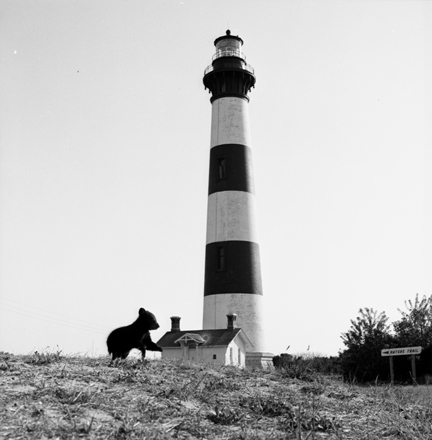 Then, the other day, I came across some of the bear cub negatives in an envelope labeled “Negatives–Zoo Trip with Little Bear–4-72,” in Morton’s hand. So, I’m guessing that Grandfather Mountain gave this bear cub to the North Carolina Zoo in April 1972, and these photos were taken on the (somewhat circuitous) trip to deposit him/her there. Can anyone confirm or deny that? Were the images used in some sort of promotional campaign?
Then, the other day, I came across some of the bear cub negatives in an envelope labeled “Negatives–Zoo Trip with Little Bear–4-72,” in Morton’s hand. So, I’m guessing that Grandfather Mountain gave this bear cub to the North Carolina Zoo in April 1972, and these photos were taken on the (somewhat circuitous) trip to deposit him/her there. Can anyone confirm or deny that? Were the images used in some sort of promotional campaign?

Memorial for JFK, May 1964
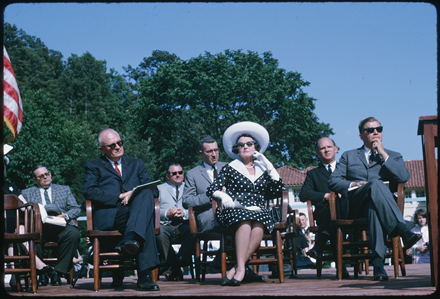
Tomorrow, Thanksgiving Day, marks the forty-fourth anniversary of the assassination of John F. Kennedy. Six months after his death, on Sunday, 17 May 1964, the state of North Carolina held a memorial service for Kennedy in Kenan Stadium on the University of North Carolina at Chapel Hill campus.
In an effort to raise money for the Kennedy presidential library, “a living memorial,” each state pledged to raise funds. Governor Terry Sanford set the state’s goal at $230,000 (the eqivalent of $1.5 million in 2007 dollars), and Hugh Morton chaired North Carolina’s fund raising effort. An estimated 12,000 people attended the memorial, paying $10.00 (about $65.00 today) to attend and contribute toward the goal. As the date drew near, the governor announced that students were to be admitted free of charge because it was determined that sufficient contributions from the community had been raised. The News and Observer noted in its report the following day that no other state in the country had yet to raise money by public subscription, and that eighty percent of the state’s goal had been met.
The memorial featured a tribute by Billy Graham and addresses by Governor Terry Sanford; Luther H. Hodges, former North Carolina governor and then current United States Secretary of Commerce; and Senator Edward Kennedy, brother of John F. Kennedy. In the photograph above, Rose Kennedy, mother of the former president, is seated on the platform with Hugh Morton (left) and Terry Sanford (right). There are several slides of the event in the collection, but the photographer is unknown.
Battle for the Victory Bell
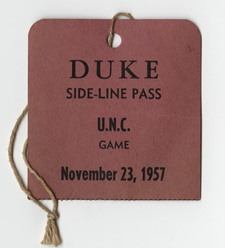 It’s that time of year, and in honor of this Saturday’s UNC-Duke football game, we thought we would revisit the same event 50 years ago: the dramatic November 23, 1957 face-off at Wallace Wade Stadium. UNC coach Jim Tatum had suspended quarterback Dave Reed a few weeks earlier in the season (prior to the Wake Forest game), and “Dook” was expected to win . . . making the Heels’ surprise 21 to 13 victory all the sweeter.
It’s that time of year, and in honor of this Saturday’s UNC-Duke football game, we thought we would revisit the same event 50 years ago: the dramatic November 23, 1957 face-off at Wallace Wade Stadium. UNC coach Jim Tatum had suspended quarterback Dave Reed a few weeks earlier in the season (prior to the Wake Forest game), and “Dook” was expected to win . . . making the Heels’ surprise 21 to 13 victory all the sweeter.
Hugh Morton was on the sidelines, of course, and we have his press pass (above) to prove it. After the game, Morton made a well-known photograph of Coach Tatum embracing an emotional Reed. That photograph is featured on page 168 of the 2003 book Hugh Morton’s North Carolina. The image below shows an enthusiastic but unidentified UNC fan in the stands that day, wearing buttons that read “Beat Dook” and “I Told You So.” Do you know who this is?

